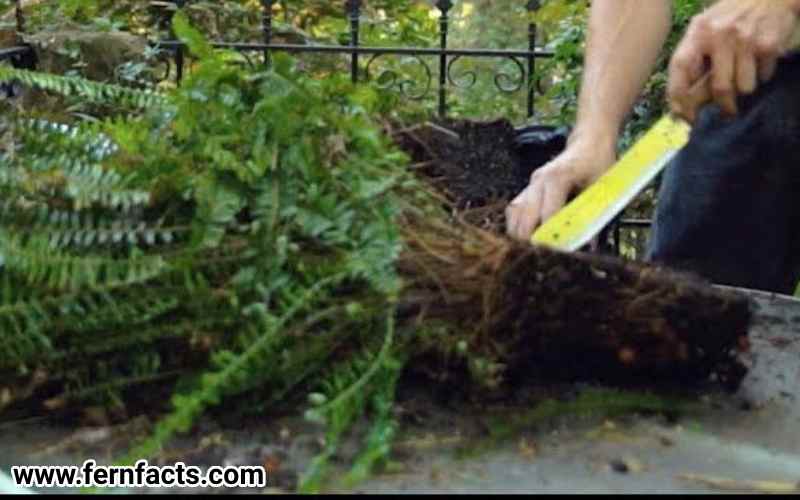Boston Fern Repotting: How and When to Repot Boston Ferns
Boston ferns are elegant evergreen plants that are the best houseplants for all plant lovers. If you own Boston ferns, you might want to know their repotting process.
Do you know why repotting is important for Boston Fern and when is the right time for repotting? If not! Then stay attached to this article.
Here I’ll be sharing the Boston ferns repotting process step-by-step guidance. Before starting the guidelines, I’ll also talk about when and why you should report your Boston ferns along with things you’ll need to report your ferns.
So let’s begin the topic with an overview of Boston fern’s characteristics.
Overview of Boston Fern
- Botanical name: Nephrolepis exaltata
- Common names: sword fern, bluebell Fern, tuber ladder Fern, Fishbone Fern
- Plants: Evergreen
- Native range: America
- Native habitats: moist shady places- humid forests, swamps, floodplains, etc
- Shade requirements: partial shade or full shade
- Height: 20 to 98 inches
- Soil pH: moderate acidic (6.0 to 6.5),
- Soil type: moist well-drained,
- Tolerance: drought
Boston Ferns are evergreen ornamental plants that are renowned among all plant lovers. These ferns are also recognized as sword ferns blue bell Fern, tuber ladder Ferns, or fishbone Ferns in many countries.
These ferns can grow to an average height of around 40 to 60 centimeters. Like other ferns, they also prefer moist, shady places, and warm atmospheres just like their natural habitats.
Note that these ferns can tolerate drought to some extent but cannot hold for too long. As they are a warm lover plant, they prefer minimal 70% to 80% humidity around themselves.
When Should You Re-pot Your Boston Fern?
Boston ferns are an evergreen plant therefore their best planting or repotting season would be spring season. Because these ferns grow actively during the spring seasons.
Therefore, if you repot your Boston ferns in the spring season, they will have robust growth after repotting.
Why Should You Re-pot Your Boston Ferns?
Certainly, there are some signs where you should understand it’s time to re-pot your Boston ferns.
Drying out too fast
If you notice your ferns are drying out quickly. If you notice that you are watering your plants more frequently in a week and the water is drying out quickly.
Then, you should be thinking about repotting your Boston ferns. Because it means you are watering your plants too much as it’s getting dried up quickly. In such cases, you must consider doing a repotting process of your Boston ferns
You can also read this content about: Kimberly Queen Fern vs Boston Fern: 8 Major Differences
Root on the Top/ Root Bound
Secondly, If you observe your Boston fern’s root on the top of their surface soil then you have to do repotting. If roots get bushy, they will not find a proper place to accommodate.
Hence, they will start coming out of the pots. Ultimately your plants will get root-bound if they don’t get enough space to breathe in. In such situations, you have to re-pot your Boston ferns.
Slow Growth
If you observe your Boston ferns are not growing actively, then you have to re-pot your ferns. It probably happens, soil texture loses its nutritional effect which is why this cannot provide nutrients to the plant’s body. Because of poor soil, their growth can be stopped.
Things You’ll Need While Repotting
There are a few things that you might need to concentrate on when you tend to re-pot your ferns. Here are:
2 Inch Bigger Pot or Container
For repotting your Boston ferns, the very first thing you will need is a new pot or container with drainage holes. You have to choose at least 2-inch larger pots from the previous one.
A new bigger pot will give your root-bounded Boston ferns sustainability by giving them proper space.
Sterilize Scissors
For dividing your plant’s root, you will need sharp scissors. For cutting small Boston ferns, you can choose any kitchen scissors if you want.
But if your Boston fern is already big enough, then you have to use quite big pruning scissors to cut off the plant’s roots. Make sure you sanitize that tool with alcohol pads or any sanitizer before using it.
How to Repot Your Boston Ferns
Let’s go through the step-by-step process of repotting your Boston ferns.
Step 1: Soaked the Soil
At the very first step, you have to water your Boston ferns to make the soil a little wet. Because it’s quite challenging to re-pot when the soil remains dry.
Give a gentle round of watering to your Boston ferns and make sure the remaining excessive water gets drained out from the drainage hole.
Step 2: Press the Side of the Pot
Now, give it a good press to the pot in order to remove your plants from the pot. If you are still unable to remove the plant from the pot, then you can cut the pot from the middle to remove your plant.
Step 3: Loosen the Soil
After removing the plants, you have to loosen up the soil from the roots. Start from the bottom part; it will give you a generous idea about their root length.
Now press and loosen up the soil from the roots while ensuring the roots ball.
Step 4: Divide the Plants Root
Now it’s the time of the division of your Boston ferns root. Simply cut off the plants from the middle by using pruning scissors. Don’t harm yourself while cutting your plants. You can wear gloves for an extra layer of protection of your hand.
Step 5: Prepare the Soil
After cutting the roots, now keep them aside while you’re making their new potting mix soil. You can buy ready-made potting soil from any local store. Also, you can make your own potting soil at home by adding soil, perlite, peat moss, leaf mold, organic compost, etc.
Step 6: Do Re-pot
Now, take your chosen container or pot which should be at least 2 inches bigger than the previous one. It will give them enough space to accommodate their roots in the pot.
Simply, put the divided part inside the pot and fill the remaining space with your new soil compost. If you don’t want to divide your plant, then after loosening up the soil, you can directly move to the repotting step.
Closing Lines
In a nutshell, Boston ferns are elegant houseplants to have in the house. Early spring would be the best time for Boston Ferns to do this process.
However, if their growth sometimes gets stopped due to poor soil conditions you need to consider repotting.
Similarly, if you notice the soil is drying too quickly, or the root gets bound then it’s time to repot your ferns.
Hopefully, you will be able to re-pot your Boston ferns by understanding all the above-mentioned guidelines.







